日耳曼语言学导论3.Phonetik und Phonologie
- 格式:ppt
- 大小:1.18 MB
- 文档页数:30
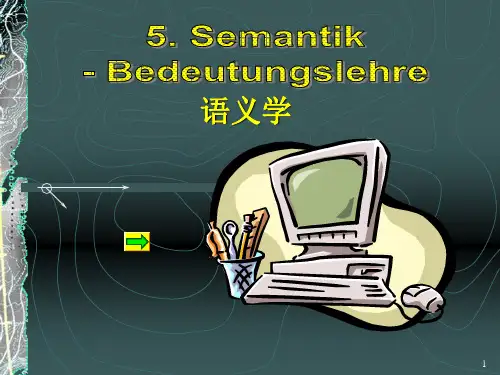

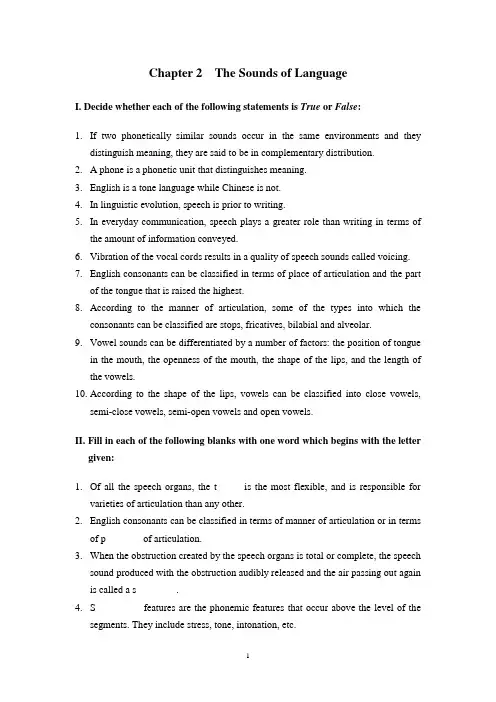
Chapter 2 The Sounds of LanguageI. Decide whether each of the following statements is True or False:1.If two phonetically similar sounds occur in the same environments and theydistinguish meaning, they are said to be in complementary distribution.2. A phone is a phonetic unit that distinguishes meaning.3.English is a tone language while Chinese is not.4.In linguistic evolution, speech is prior to writing.5.In everyday communication, speech plays a greater role than writing in terms ofthe amount of information conveyed.6.Vibration of the vocal cords results in a quality of speech sounds called voicing.7.English consonants can be classified in terms of place of articulation and the partof the tongue that is raised the highest.8.According to the manner of articulation, some of the types into which theconsonants can be classified are stops, fricatives, bilabial and alveolar.9.Vowel sounds can be differentiated by a number of factors: the position of tonguein the mouth, the openness of the mouth, the shape of the lips, and the length of the vowels.10.According to the shape of the lips, vowels can be classified into close vowels,semi-close vowels, semi-open vowels and open vowels.II. Fill in each of the following blanks with one word which begins with the letter given:1.Of all the speech organs, the t ____ is the most flexible, and is responsible forvarieties of articulation than any other.2.English consonants can be classified in terms of manner of articulation or in termsof p_______ of articulation.3.When the obstruction created by the speech organs is total or complete, the speechsound produced with the obstruction audibly released and the air passing out again is called a s________.4.S_________ features are the phonemic features that occur above the level of thesegments. They include stress, tone, intonation, etc.5.The rules that govern the combination of sounds in a particular language arecalled s____ rules.6.The transcription of speech sounds with letter-symbols only is called broadtranscription while the transcription with letter-symbols together with the diacritics is called n_________ transcription.7.When pitch, stress and sound length are tied to the sentence rather than the wordin isolation, they are collectively known as i_________.8.P___________ is a discipline which studies the system of sounds of a particularlanguage and how sounds are combined into meaningful units to effect linguistic communication.9.T_______ are pitch variations, which are caused by the differing rates of vibrationof the vocal cords and which can distinguish meaning just like phonemes.10.Depending on the context in which stress is considered, there are two kinds ofstress: word stress and s_________ stress.III. Define the terms below:1. phoneme2.allophone3. International Phonetic Alphabet4. intonation5. auditory phonetics6. acoustic phonetics7. minimal pairIV. Answer the following questions as comprehensively as possible. Give examples for illustration if necessary:1.What are the major differences between phonology and phonetics?2.Illustrate with examples how suprasegmental features can affect meaning.3.In what way can we determine whether a phone is a phoneme or not?Suggested AnswersI. 1. F 2. F 3. F 4.T 5. T 6. T 7. F 8. F 9. T 10. FII.1. tongue2. place3. stop4. Suprasegmental5. sequential6. narrow7. intonation8. Phonology9. Tone 10. sentenceIII.1.Phoneme: The basic unit in phonology is called phoneme; it is a unit of distinctivevalue. But it is an abstract unit. To be exact, a phoneme is not a sound; it is a collection of distinctive phonetic features.2.Allophone: The different phones which can represent a phoneme in differentphonetic environments are called the allophones of that phoneme.3.International phonetic alphabet: It is a standardized and internationally acceptedsystem of phonetic transcription.4.Intonation: When pitch, stress and sound length are tied to the sentence rather thanthe word in isolation, they are collectively known as intonation.5.Auditory phonetics: It studies the speech sounds from the hearer's point of view. Itstudies how the sounds are perceived by the hearer.6.Acoustic phonetics: It studies the speech sounds by looking at the sound waves. Itstudies the physical means by which speech sounds are transmitted through the air from one person to another.7.Minimal pair: When two different forms are identical in every way except for onesound segment which occurs in the same place in the strings, the two words are said to form a minimal pair.IV.1. They differ in their approach and focus. Phonetics is of a general nature; it isinterested in all the speech sounds used in all human languages: how they are produced, how they differ from each other, what phonetic features they possess, how they can be classified. Phonology, on the other hand, is interested in the system of sounds of a particular language; it aims to discover how speech soundsin a language form patterns and how these sounds are used to convey meaning in linguistic communication.2. 1) The location of stress in English distinguishes meaning, such as `import andim`port. The similar alternation of stress also occurs between a compound noun and a phrase consisting of the same elements. A phonological feature of the English compounds, is that the stress of the word always falls on the first element and the second element receives secondary stress, for example: 'blackbird is a particular kind of bird, which is not necessarily black, but a black `bird is a bird that is black.2) The more important words such as nouns, verbs adjectives, adverbs, etc. arepronounced with greater force and made more prominent. But to give special emphasis to a certain notion, a word in sentence that is usually unstressed can be stressed to achieve different effect. Take the sentence “He is driving my car.” for example. To emphasize the fact that the car he is driving is not his, or yours, but mine, the speaker can stress the possessive pronoun my, which under normal circumstances is not stressed.3) English has four basic types of intonation, known as the four tones: Whenspoken in different tones, the same sequence of words may have different meanings. Generally speaking, the falling tone indicates that what is said is a straight-forward, matter-of-fact statement, the rising tone often makes a question of what is said, and the fall-rise tone often indicates that there is an implied message in what is said.3. A basic way to determine the phonemes of a language is to see if substituting onesound for another results in a change of meaning. If it does, the two sounds then represent different phonemes.。
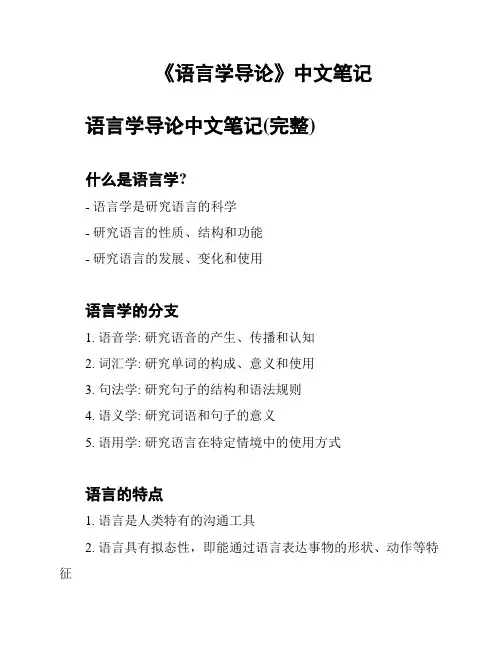
《语言学导论》中文笔记语言学导论中文笔记(完整)什么是语言学?- 语言学是研究语言的科学- 研究语言的性质、结构和功能- 研究语言的发展、变化和使用语言学的分支1. 语音学: 研究语音的产生、传播和认知2. 词汇学: 研究单词的构成、意义和使用3. 句法学: 研究句子的结构和语法规则4. 语义学: 研究词语和句子的意义5. 语用学: 研究语言在特定情境中的使用方式语言的特点1. 语言是人类特有的沟通工具2. 语言具有拟态性,即能通过语言表达事物的形状、动作等特征3. 语言具有符号性,即语言中的单词和语法符号代表着特定的意义4. 语言是可以研究和教授的,通过语言能够传递文化和知识语言的功能1. 意指功能: 通过语言表达思想、情感和意图2. 表示功能: 通过语言描述和描绘事物、现象和过程3. 交际功能: 通过语言实现沟通和交流4. 记忆功能: 通过语言记录和传递信息5. 心理功能: 通过语言影响和塑造个体的心理活动语言与文化- 语言是文化的一部分,反映了社会和文化的价值观和观念- 不同的语言体现了不同的文化方式和思维方式- 语言的变化和发展与文化的变迁和演变相互关联语言的变化和发展- 语言是动态的,不断发展和变化- 语言变化的原因包括:社会文化变迁、语言接触和语言演化- 语言变化常常由语言使用者的创新和共同接受推动语言的使用- 语言使用涉及语言使用者的语法知识、语境理解和交际目的- 语言的使用方式受到社会、文化、地域等因素的影响- 语言的使用也受到个体因素和语言使用者之间的关系影响以上是《语言学导论》的简要笔记,介绍了语言学的定义、分支、特点、功能、与文化关系、变化和使用等方面的内容。
对于进一步学习语言学的人来说,这份笔记能够提供一个全面的概览,并为深入研究打下基础。
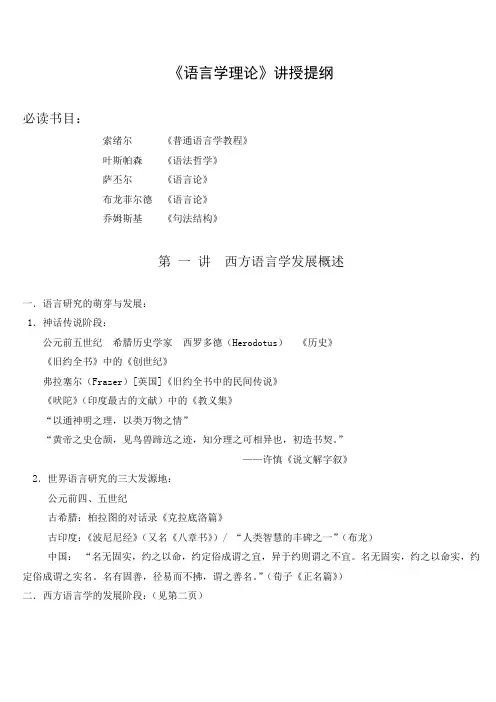
《语言学理论》讲授提纲必读书目:索绪尔《普通语言学教程》叶斯帕森《语法哲学》萨丕尔《语言论》布龙菲尔德《语言论》乔姆斯基《句法结构》第一讲西方语言学发展概述一.语言研究的萌芽与发展:1.神话传说阶段:公元前五世纪希腊历史学家西罗多德(Herodotus)《历史》《旧约全书》中的《创世纪》弗拉塞尔(Frazer)[英国]《旧约全书中的民间传说》《吠陀》(印度最古的文献)中的《教义集》“以通神明之理,以类万物之情”“黄帝之史仓颉,见鸟兽蹄迒之迹,知分理之可相异也,初造书契。
”——许慎《说文解字叙》2.世界语言研究的三大发源地:公元前四、五世纪古希腊:柏拉图的对话录《克拉底洛篇》古印度:《波尼尼经》(又名《八章书》)/ “人类智慧的丰碑之一”(布龙)中国:“名无固实,约之以命,约定俗成谓之宜,异于约则谓之不宜。
名无固实,约之以命实,约定俗成谓之实名。
名有固善,径易而不拂,谓之善名。
”(荀子《正名篇》)二.西方语言学的发展阶段:(见第二页)第二讲古希腊罗马的语言研究一.古希腊哲学家的语言研究:1.公元前四世纪,关于名称与事物关系的争论。
(柏拉图《克拉底洛篇》)克拉底洛:名称由性质产生,语言自然具有意义。
赫尔摩根:名称指称事物由于惯例,使用者达成的协议可以改变。
苏格拉底:论述两种观点的优缺点。
如:catastrophe(大祸) = cat(猫) + astro(天体) + fee(费用) rho 音表示运动。
但例外由惯例造成。
反映了“自然派”(柏拉图、斯多葛派)与“惯例派”(亚里士多德及其学生)的不同看法。
引起探索词源的浓厚兴趣。
1.按时间划分: 2.按每一时期的主要倾向划分: 500B.C.斯多依葛学派(本质派,不规则派)语文学希语法创始人:齐诺(Zeno)上腊特拉克斯(Thrax)亚历山大里亚学派(习俗派,类推派)时《语法术》创始人:阿里斯塔库斯(Aristarchus)期齐诺多塔斯(Zenodotus)300B.C.罗语法古马瓦罗(Varro)代表:多纳塔斯(Donatus)时(区分屈折普列希安(Priscian)期和派生)500A.D.“纯理语法”中代表:孔切斯(William of Conches)只研究拉丁语海里阿斯(Peter Helias)古贝肯(Roger Bacon)1400A.D.经验主义:[英] 洛克(Locke)传统语法文培根(Bacon)艺收集语言材料理性主义:[法] 笛卡尔(Descartes)复出现描写语法 [法] 波尔罗瓦雅学派兴历史主义观点“普遍唯理语法”1800A.D.[德] 洪堡特十历史比较法 [丹] 拉斯克历史比较九语音演变规律 [德] 葆朴、格里姆、施莱歇尔语言学世构拟原始语别 [德] 新语法学派纪“谱系树” [法] 社会学派1900A.D.现代语言学诞生 [瑞] 索绪尔《普通语言学教程》结构主义思潮 [匈] 布拉格功能学派结构语言学二 [丹] 哥本哈根语符学派十 [美] 描写语言学派世萨丕尔、布龙菲尔德纪转换生成理论 [美] 转换生成语法学派生成语言学乔姆斯基《句法理论》2.传统语法范畴体系的确立。
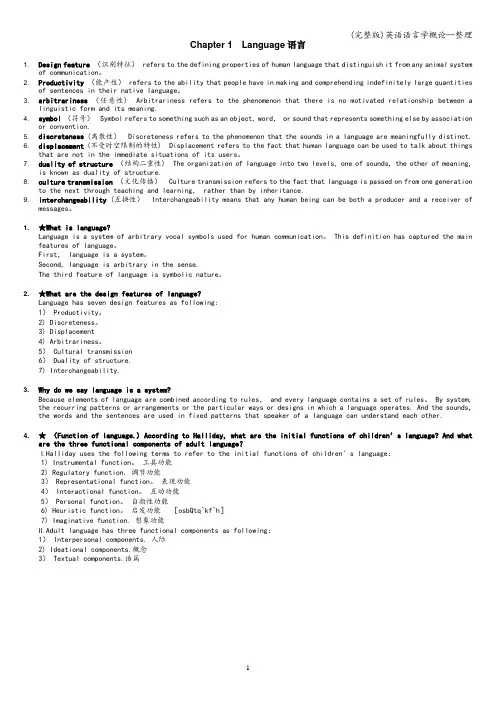
Chapter 1 Language语言1. Design feature (识别特征) refers to the defining properties of human language that distinguish it from any animal systemof communication。
2. Productivity(能产性) refers to the ability that people have in making and comprehending indefinitely large quantitiesof sentences in their native language。
3. arbitrariness (任意性) Arbitrariness refers to the phenomenon that there is no motivated relationship between alinguistic form and its meaning.4. symbol (符号) Symbol refers to something such as an object, word, or sound that represents something else by associationor convention.5. discreteness (离散性) Discreteness refers to the phenomenon that the sounds in a language are meaningfully distinct.6. displacement(不受时空限制的特性) Displacement refers to the fact that human language can be used to talk about thingsthat are not in the immediate situations of its users。
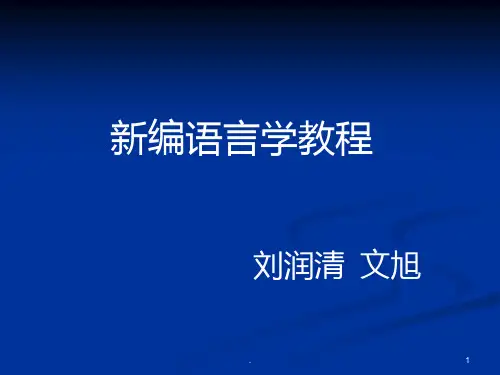
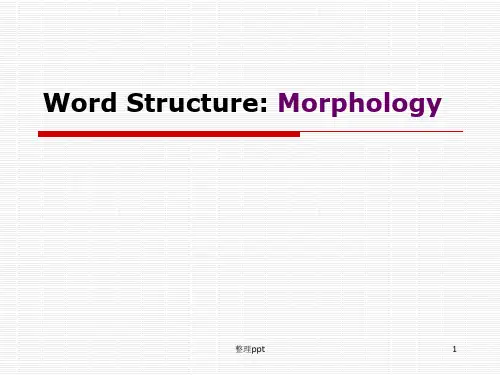

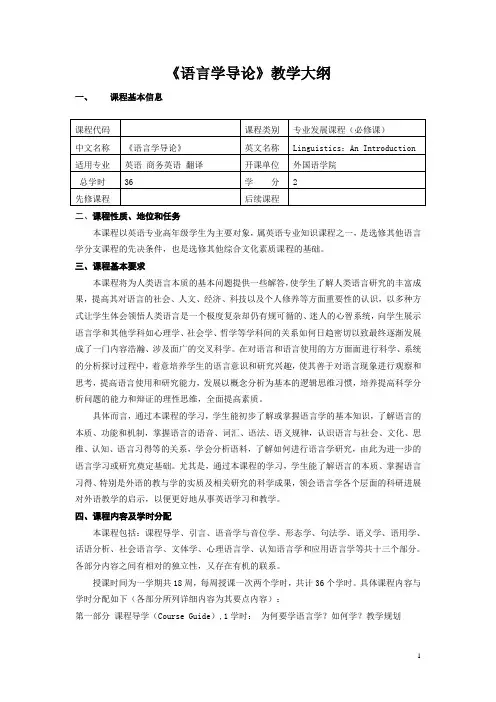
《语言学导论》教学大纲一、课程基本信息二、课程性质、地位和任务本课程以英语专业高年级学生为主要对象,属英语专业知识课程之一,是选修其他语言学分支课程的先决条件,也是选修其他综合文化素质课程的基础。
三、课程基本要求本课程将为人类语言本质的基本问题提供一些解答,使学生了解人类语言研究的丰富成果,提高其对语言的社会、人文、经济、科技以及个人修养等方面重要性的认识,以多种方式让学生体会领悟人类语言是一个极度复杂却仍有规可循的、迷人的心智系统,向学生展示语言学和其他学科如心理学、社会学、哲学等学科间的关系如何日趋密切以致最终逐渐发展成了一门内容浩瀚、涉及面广的交叉科学。
在对语言和语言使用的方方面面进行科学、系统的分析探讨过程中,着意培养学生的语言意识和研究兴趣,使其善于对语言现象进行观察和思考,提高语言使用和研究能力,发展以概念分析为基本的逻辑思维习惯,培养提高科学分析问题的能力和辩证的理性思维,全面提高素质。
具体而言,通过本课程的学习,学生能初步了解或掌握语言学的基本知识,了解语言的本质、功能和机制,掌握语言的语音、词汇、语法、语义规律,认识语言与社会、文化、思维、认知、语言习得等的关系,学会分析语料,了解如何进行语言学研究,由此为进一步的语言学习或研究奠定基础。
尤其是,通过本课程的学习,学生能了解语言的本质、掌握语言习得、特别是外语的教与学的实质及相关研究的科学成果,领会语言学各个层面的科研进展对外语教学的启示,以便更好地从事英语学习和教学。
四、课程内容及学时分配本课程包括:课程导学、引言、语音学与音位学、形态学、句法学、语义学、语用学、话语分析、社会语言学、文体学、心理语言学、认知语言学和应用语言学等共十三个部分。
各部分内容之间有相对的独立性,又存在有机的联系。
授课时间为一学期共18周,每周授课一次两个学时,共计36个学时。
具体课程内容与学时分配如下(各部分所列详细内容为其要点内容):第一部分课程导学(Course Guide),1学时:为何要学语言学?如何学?教学规划第二部分导言(Preliminaries),2学时:语言的定义、语言的本质特征、语言的功能、语言学的性质及研究范围、语言学简史第三部分语音学与音位学(Phonetics and Phonology),3学时:语音学的范围、英语语音的描述与分类、音素、音位学的范围、音位分析、超音位分析第四部分形态学(Morphology),3学时:词的定义、词位、词素、构词法第五部分句法学(Syntax),3学时:句法研究的性质与范围、词类、转换生成语法、功能句法第六部分语义学(Semantics),3学时:语义学研究范围、词义分析、词之间的意义关系、句子与命题、句子意义分析、句之间的意义关系、语义变化机制第七部分语用学(Pragmatics),3学时:语用学研究范围、指示语、预设、言语行为理论、合作原则、会话含意理论、会话分析第八部分话语分析(Discourse analysis),3学时:话语分析研究范围、信息结构、衔接与连贯、话语标记语、多模态语篇分析、批评话语分析第九部分社会语言学(Sociolinguistics),3学时:社会语言学研究范围、语言变体、语言与性别、语码选择、语言规划、社会语言学研究方法第十部分文体学(Stylistics),3学时:研究范围、文体标记、文体分析的语言学方法、实用文体学第十一部分心理语言学(Psycholinguistics),3学时:语言产生、语言理解、语言习得第十二部分认知语言学(Cognitive linguistics),3学时:范畴与范畴化、概念隐喻、概念转喻、意象图式、识解、象似性第十三部分应用语言学(Applied Linguistics),3学时:二语习得、错误分析、中介语、二语教学、语言测试五、课程教材及主要参考资料教材:文旭,《语言学导论》(Linguistics: An Introduction)。

语言与交际导论Chapter 3: 语音学和音位描写(phonetics and phonemic transcription)一、相关知识1、发音所涉及的生理学(physiology of speech production)发音过程所涉及的部位有咽喉,口腔和鼻腔,以及一百块肌肉直接和后续的拉动。
2、发音过程中从肺流出的气流(airflows from the lungs during speech)。
发音过程中肺部流出的气流与呼吸的不同点:1、气流数量三或四倍于呼吸;2、肺部气流的呼吸节奏变化更急促,表现为吸气更快,呼气更为持久(more drawn out);3、发音过程中每个时间单位中的呼吸次数更多;4、在咽喉和口腔中气流会受阻或封闭,而平稳呼吸则是未受阻的(unimpeded)。
3、隔膜(diaphragm):一片将腹腔(abdominal region)和胸腔(chest cavity) 隔开来的肌肉组织。
所以,隔膜降低,胸腔随之扩大。
肌肉收缩,肋骨(rib)上升。
肺紧贴胸腔壁,当胸腔扩大(不论是因为隔膜收缩还是肋骨上升导致),肺随之变大,接着,空气流入,当吸气过程完成时气流达到顶点。
4、喉(larynx)在发音过程中的作用喉是气流从肺部出来第一个受阻的地方,喉位于气管(trachea)的最上端。
而这种受阻则是受声带(vocal fold, or, vocal cord)张弛的影响。
当平稳呼吸(quiet breathing)时,声带处于放松状态,允许气流从肺部自由出入;而当吞咽时,声带拉紧,阻止外来物进入肺部。
对发音而言,最重要的是声带能振动,能导致声带快速振动的音我们则成为带声音(voicing, or, phonation),而振动频率(frequency)决定了音调或音高(pitch)。
因为成年男性声带较女性和儿童的大,所以振动频率低。
5、声道(the vocal tract)声道位于声带上端,包括咽(pharynx),口腔(oral cavity),和鼻腔(nasal cavity),是人类语言的发声的地方。
Chapter2TheSoundsofLanguage_语言学导论Chapter 2 The Sounds of LanguageI. Decide whether each of the following statements is True or False:1.If two phonetically similar sounds occur in the same environments and theydistinguish meaning, they are said to be in complementary distribution.2. A phone is a phonetic unit that distinguishes meaning.3.English is a tone language while Chinese is not.4.In linguistic evolution, speech is prior to writing.5.In everyday communication, speech plays a greater role than writing in terms ofthe amount of information conveyed.6.Vibration of the vocal cords results in a quality of speech sounds called voicing.7.English consonants can be classified in terms of place of articulation and the partof the tongue that is raised the highest.8.According to the manner of articulation, some of the types into which theconsonants can be classified are stops, fricatives, bilabial and alveolar.9.Vowel sounds can be differentiated by a number of factors: the position of tonguein the mouth, the openness of the mouth, the shape of the lips, and the length of the vowels.10.According to the shape of the lips, vowels can be classified into close vowels,semi-close vowels, semi-open vowels and open vowels.II. Fill in each of the following blanks with one word which begins with the letter given:1.Of all the speech organs, the t ____ is the most flexible, and is responsible forvarieties of articulation than any other.2.English consonants can be classified in terms of manner of articulation or in termsof p_______ of articulation.3.When the obstruction created by the speech organs is total or complete, the speechsound produced with the obstruction audibly released and the air passing out again is called a s________.4.S_________ features are the phonemic features that occur above the level of thesegments. They include stress, tone, intonation, etc.5.The rules that govern the combination of sounds in a particular language arecalled s____ rules.6.The transcription of speech sounds with letter-symbols only is called broadtranscription while the transcription with letter-symbols together with the diacritics is called n_________ transcription.7.When pitch, stress and sound length are tied to the sentence rather than the wordin isolation, they are collectively known as i_________.8.P___________ is a discipline which studies the system of sounds of a particularlanguage and how sounds are combined into meaningful units to effect linguistic communication.9.T_______ are pitch variations, which are caused by the differing rates of vibrationof the vocal cords and which can distinguish meaning just like phonemes.10.Depending on the context in which stress is considered, there are two kinds ofstress: word stress and s_________ stress.III. Define the terms below:1. phoneme2.allophone3. International Phonetic Alphabet4. intonation5. auditory phonetics6. acoustic phonetics7. minimal pairIV. Answer the following questions as comprehensively as possible. Give examples for illustration if necessary:1.What are the major differences between phonology and phonetics?2.Illustrate with examples how suprasegmental features can affect meaning.3.In what way can we determine whether a phone is a phoneme or not?Suggested AnswersI. 1. F 2. F 3. F 4.T 5. T 6. T 7. F 8. F 9. T 10. FII.1. tongue2. place3. stop4. Suprasegmental5. sequential6. narrow7. intonation8. Phonology9. Tone 10. sentenceIII.1.Phoneme: The basic unit in phonology is called phoneme; it is a unit of distinctivevalue. But it is an abstract unit. To be exact, a phoneme is nota sound; it is a collection of distinctive phonetic features.2.Allophone: The different phones which can represent a phoneme in differentphonetic environments are called the allophones of that phoneme.3.International phonetic alphabet: It is a standardized and internationally acceptedsystem of phonetic transcription.4.Intonation: When pitch, stress and sound length are tied to the sentence rather thanthe word in isolation, they are collectively known as intonation.5.Auditory phonetics: It studies the speech sounds from the hearer's point of view. Itstudies how the sounds are perceived by the hearer.6.Acoustic phonetics: It studies the speech sounds by looking at the sound waves. Itstudies the physical means by which speech sounds are transmitted through the air from one person to another.7.Minimal pair: When two different forms are identical in every way except for onesound segment which occurs in the same place in the strings, the two words are said to form a minimal pair.IV.1. They differ in their approach and focus. Phonetics is of a general nature; it isinterested in all the speech sounds used in all human languages: how they are produced, how they differ from each other, what phonetic features they possess, how they can be classified. Phonology, on the other hand, is interested in the system of sounds of a particular language; it aims to discover how speech soundsin a language form patterns and how these sounds are used to convey meaning in linguistic communication.2. 1) The location of stress in English distinguishes meaning, such as `import andim`port. The similar alternation of stress also occurs between a compound noun and a phrase consisting of the same elements.A phonological feature of the English compounds, is that the stress of the word always falls on the first element and the second element receives secondary stress, for example: 'blackbird is a particular kind of bird, which is not necessarily black, but a black `bird is a bird that is black.2) The more important words such as nouns, verbs adjectives, adverbs, etc. arepronounced with greater force and made more prominent. But to give special emphasis to a certain notion, a word in sentence that is usually unstressed can be stressed to achieve different effect. Take the sentence “He is driving my car.” for example. To emphasize the fact that the car he is driving is not his, or yours, but mine, the speaker can stress the possessivepronoun my, which under normal circumstances is not stressed.3) English has four basic types of intonation, known as the four tones: Whenspoken in different tones, the same sequence of words may have different meanings. Generally speaking, the falling tone indicates that what is said is a straight-forward, matter-of-fact statement, the rising tone often makes a question of what is said, and the fall-rise tone often indicates that there is an implied message in what is said.3. A basic way to determine the phonemes of a language is to see if substituting onesound for another results in a change of meaning. If it does, the two sounds then represent different phonemes.。